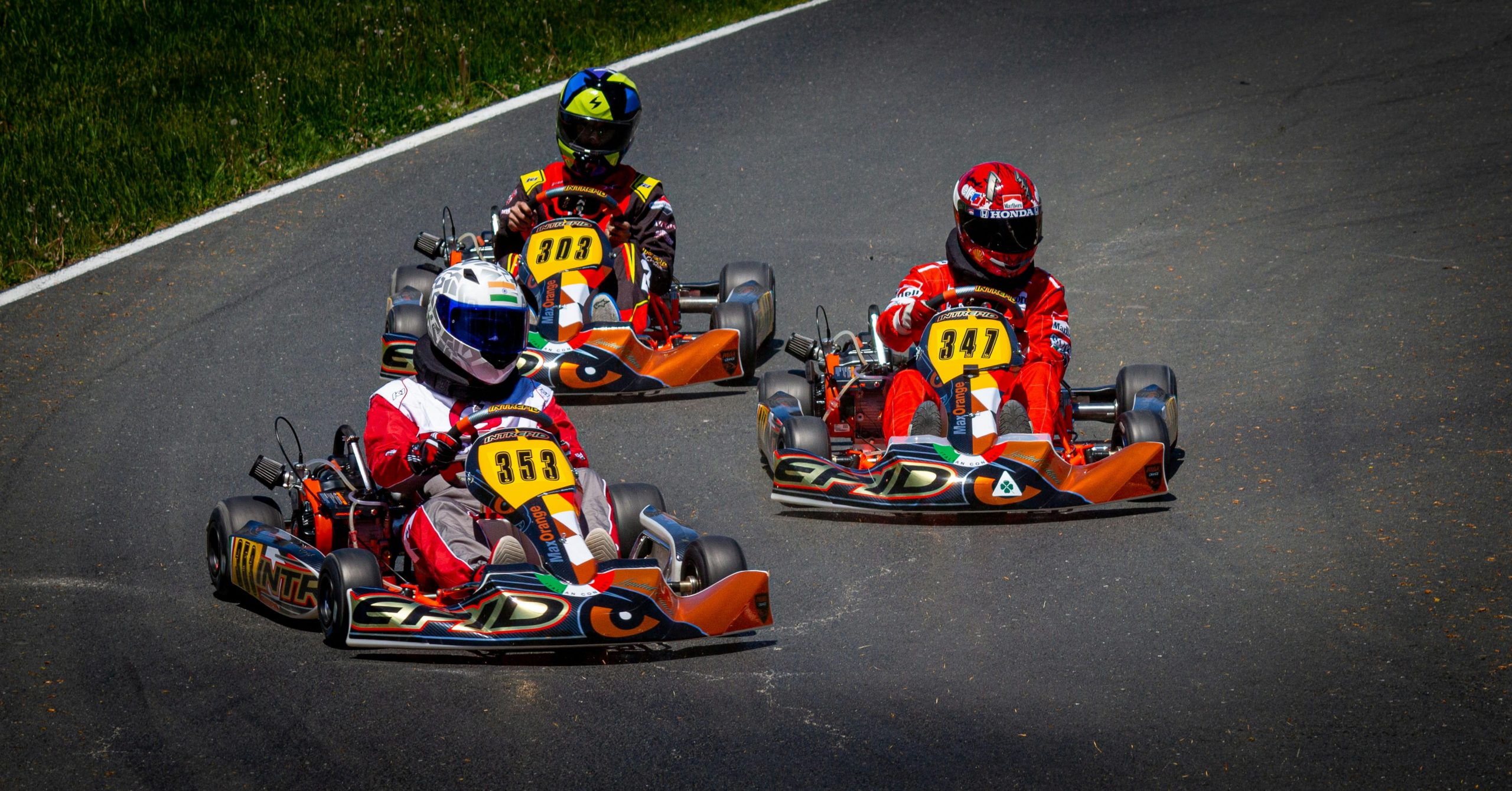Kart racing: what is it?
Karting, another name for kart racing, is a thrilling motorsport that is enjoyable and accessible to a wide range of people, both young and elderly. In this sport, drivers compete in little, low-power cars known as karts on made-up or customized circuits. Globally acknowledged as the first stage for those wishing to pursue motorsports, it provides a special fusion of skill, speed, and competitiveness.
Karting’s price and ease of use set it apart from other racing disciplines. These karts are a more affordable entrance point into the racing scene because they don’t have the intricate and costly parts of more expensive racing cars. The key to karting is its ability to impart the basic racing abilities, like high-speed cornering, braking, and steering. Karting served as a springboard for many professional racers, giving them the fundamental racing abilities necessary for success in any motorsport. Kart racing is therefore a stand-alone sport that provides great challenge and satisfaction as well as a doorway into more competitive racing settings.
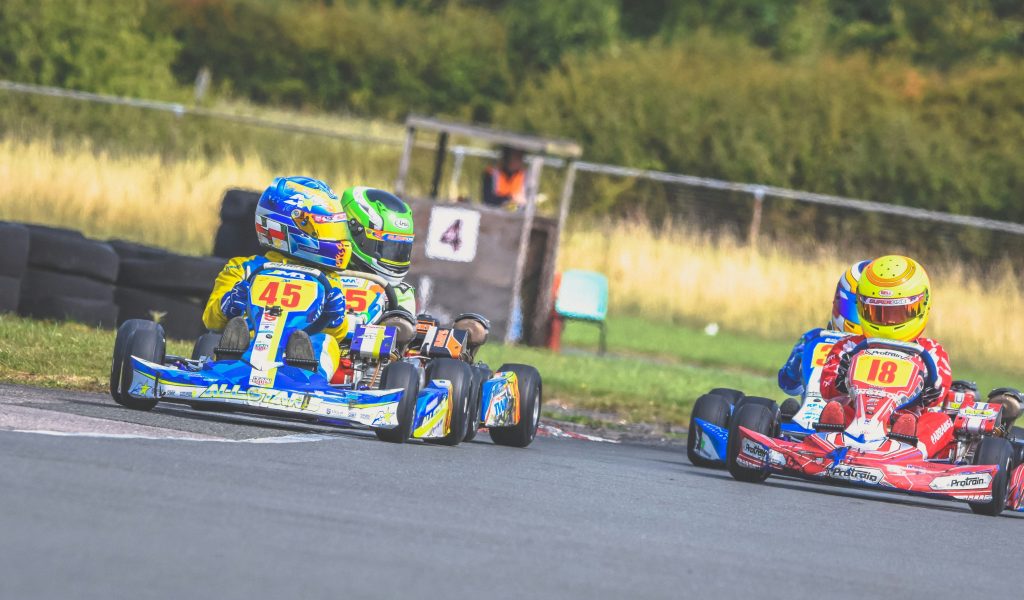
The Joy and Fundamentals of Racing
Because of its short separation from the track and low ground clearance, which increases the sense of speed, karting provides an exciting experience. A thrilling activity for players of all ages, karting combines this pleasure with a requirement for ability and precision. A modest engine and a tubular frame without suspension make up a basic kart. The pleasure is increased by the driver’s low seating position, which also necessitates extreme control and concentration.
It’s essential for novices to comprehend the fundamentals of kart handling and mechanics. The joy of karting frequently comes from being in control of these straightforward but capable vehicles. It takes skill to maneuver a kart around tight turns, control smooth accelerations, and provide appropriate braking. Understanding the racing line, or the best course on the track for obtaining the fastest lap time, is another aspect of learning the fundamentals of karting. When these components are mastered, karting becomes an art form as well as a sport.
Essential Gear for Racing Karts
In kart racing, utility and safety are crucial, necessitating specific equipment. The kart itself is fundamental, and it needs to be appropriate for the type of racing and the competitor’s level of competition. A good helmet that ideally satisfies international requirements is necessary for personal safety. A racing suit completes this, acting as some protection against heat from the engine and exhaust in addition to providing safety in the case of a collision.
Boots and gloves for racing are also necessary. During races, which frequently need tight grips and fast maneuvers, gloves protect the hands and guarantee a solid grasp on the steering wheel. Contrarily, racing boots are made to protect the feet while enabling precise pedal manipulation. Particularly for kids and novices, neck collars and rib shields are advised for total safety. These items of gear are a minimal investment for safety in a sport that mixes fast speeds and intense competition, as they guard against typical racing injuries.
The Development and History of Kart Racing
Known as the father of karting, Art Ingels built the first kart in his California garage in the late 1950s, sparking the sport’s inception. This straightforward car with a lawnmower engine acquired appeal fast, laying the groundwork for what would eventually become a worldwide hit. Karting has developed over the years from backyard experiments to a highly organized motorsports category with its own unique classes, global regulations, and specialized courses.
The sophistication of the karts and the way events are planned have advanced along with the sport. With national and international regulating bodies in charge of the sport, karting has become increasingly popular worldwide. These groups guarantee uniform guidelines, safety standards, and equitable competition. Technological developments in kart design, safety equipment, and track construction have also contributed to the growth of karting, making it safer and more widely available. Even in modern times, karting is a well-liked pastime and a serious entry step for individuals who want to advance to more competitive motorsports.
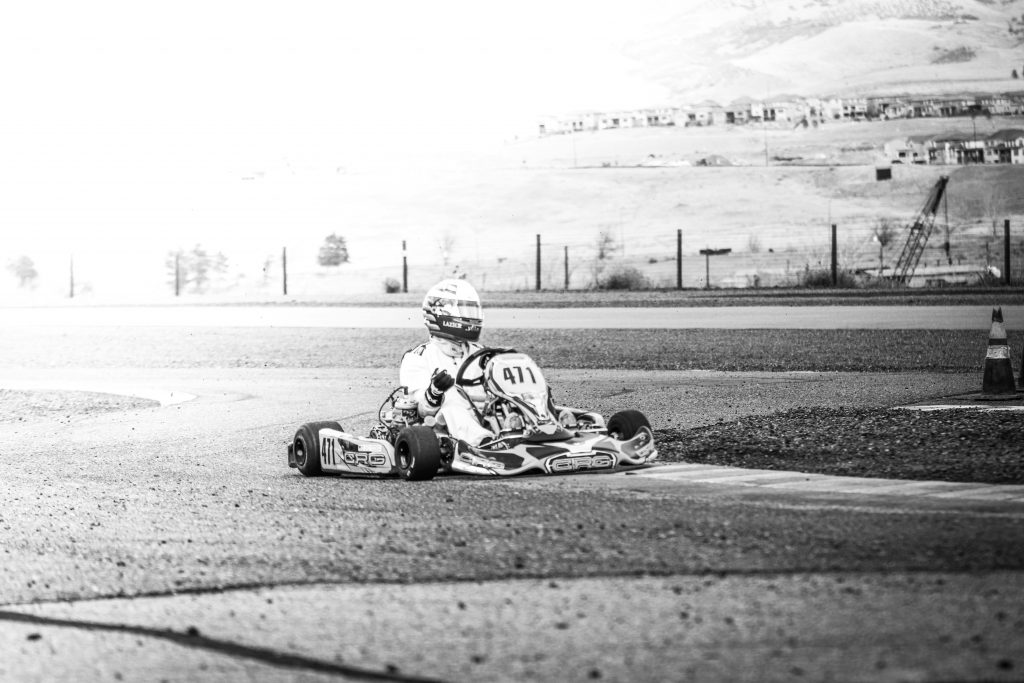
The Forerunners in Motorsport
Kart racing’s pioneers, including people like Art Ingels, created the framework for what would eventually grow to be a regulated and popular sport. Driven by accessibility and simplicity, Ingels’ breakthrough struck a chord with a large number of people and generated a lot of curiosity. Other fans built their own karts after seeing him do it, experimenting with different engines and frames. The invention of the first karting tracks and contests was made possible by the substantial contribution of this innovative age to the growth of karting.
Even now, these early pioneers’ achievements are acknowledged. In addition to creating the vehicles, they also created the competition structures that have advanced the sport. Their commitment to karting’s promotion resulted in its acceptance as a respectable motorsport. Their work has been crucial in creating a community of aficionados and racers who will carry on developing the sport and guaranteeing its place in racing’s future.
Historical Turning Points in Kart Racing
Since its beginning, kart racing has experienced a number of significant turning points that have contributed to its current standing as a well known sport. The construction of the first official karting circuit in the early 1960s was one of the first big turning points since it provided enthusiasts with a more controlled and safe racing environment. Soon after, the first karting regulatory organization was established, standardizing regulations and setting up competitions.
The entry of karting into the world of international sports is another noteworthy turning point. Karting’s official recognition as a legitimate motorsport began in the 1980s when it was acknowledged by the world’s premier motorsport body, the Fédération Internationale de l’Automobile (FIA). Increased safety precautions and better organized, competitive races were made possible in part by this recognition.
Furthermore, kart racing technology has always advanced. Modern karts include sophisticated engineering with concerns for aerodynamics, materials science, and safety technology, in contrast to the early karts’ simple motors and uncomplicated frames. These developments have increased the sport’s accessibility, safety, and competitiveness, which has added to its continuing appeal.
How to Begin Your Kart Racing Career
The first steps for everyone interested in kart racing are to familiarize themselves with the equipment needed and the requirements of the sport. Usually, the initial step is to familiarize yourself with the various kart kinds and racing styles. There are many different kinds of karts, such as those made for kids, novices, and competitive racing. Knowing these possibilities enables beginners to select the appropriate karting discipline for their age, size, and degree of enthusiasm.
The next stage is to get the required equipment and become acquainted with the local racetracks and kart clubs. There are karting clubs all over the place that invite new members and loan out equipment so that novices can begin training without having to make a big initial commitment. These groups frequently offer training sessions, which are quite helpful for picking up driving skills and safety procedures.
Beginners should also be aware of the fundamentals of kart racing, such as the competitive structure, racing flags, and track etiquette. In addition to ensuring safety, this core understanding makes novice participants knowledgeable and confident, which improves the entire experience.
Selecting Your Initial Kart
Making the right choice on your first kart can have a big impact on your racing career. Beginners ought to begin with a model that is doable but still able to offer genuine racing experiences. Considerations include weight class, tire selection, engine type, and chassis adaptability. Because four-stroke engines are often easier to manage and maintain than two-stroke engines, which have greater power, beginners may prefer karts with four-stroke engines.
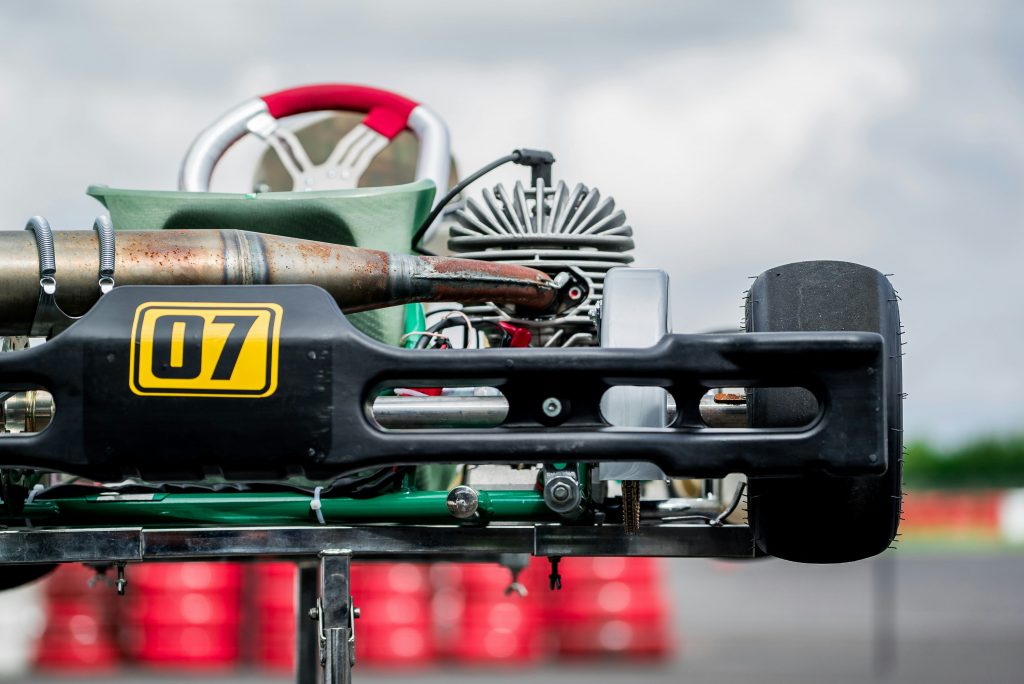
When selecting a kart, novice racers should speak with coaches or more seasoned competitors. To assist novices in making educated selections, a lot of kart stores provide guidance and even test drives. For people who are new to the sport, buying a used kart might also be a wise choice because it’s usually less expensive and involves less danger if the activity is not pursued long-term.
Crucial Safety Equipment for Novices
It is impossible to overstate the significance of safety in kart racing. Beginners should spend money on high-quality safety equipment to guard against typical karting injuries. The most important item of safety gear is the helmet, which must to be compliant with the safety regulations in effect in the racer’s area. The greatest helmets are those made especially for motorsports since they are built to withstand hits at high speeds.
During races, wearing the appropriate racing suit is essential for both comfort and safety. In the event of an accident, these suits’ fire-resistant fabrics will shield drivers from burn injuries. Racing boots and gloves complete the outfit by adding more protection to the hands and feet, which are especially exposed during competitions. Beginners should also think about wearing neck supports and rib guards to prevent sprains and other impact-related injuries that are frequently sustained when karting.
Karting Clubs and Tracks in the Area
One of the greatest methods to get started in karting for beginners is to join a local club. Tracks are made available by these clubs, and practicing and refining racing techniques is highly recommended. Clubs provide a platform for racers to network and develop their skills by organizing regular training sessions, contests, and social gatherings.
A variety of tracks, from novice circuits with few obstacles to advanced tracks with intricate bends and fast parts, are available at most karting clubs. Joining a club also gives you the chance to participate in races, which is essential if you want to get experience in a competitive environment. Moreover, club memberships can include extra perks like savings on purchases, equipment rentals, and race entry costs.
Anyone interested in kart racing can get a strong foundation of knowledge from these enlarged sections, which provide a thorough look into every facet of the sport. Every component is designed to pique the reader’s interest with educational material and entice them to learn more about the exciting world of kart racing.
Strategies & Methods for Racing Karts
Speed is not the only factor in kart racing; strategy and technique are also important. To become a master driver, one must be able to control the kart in a variety of racing situations, which applies to both novice and experienced drivers. This entails mastering the art of approaching turns, carefully passing other karts, and controlling speed without losing control.

A thorough understanding of racing lines—the best routes around the track—is necessary for handling a kart effectively. During practice sessions, beginners should begin by learning these lines, paying particular attention to how to enter and exit corners as quickly and efficiently as possible. Furthermore, boosting lap times requires an awareness of braking points, which occur when a driver begins to slow down before a corner, and acceleration points, which occur when a driver accelerates out of a corner.
In addition to driving tactics, race strategies like controlling tire wear and drafting—which involves trailing another kart closely to reduce air resistance—also have a significant impact on kart racing. To build a strong foundation, novices should concentrate on these principles before advancing to more complex racing strategies utilized in competitive environments.
Acquiring Proficiency in Kart Handling
One of the key abilities that sets decent racers apart from exceptional ones is kart handling. Due to their inherent responsiveness, karts can respond quickly to even slight changes in input. In particular, when racing, novice drivers need to learn how to balance these inputs in order to stay in control. This calls for a coordinated effort from the throttle, brakes, and steering.
Drivers can better learn how their karts respond to varied situations by gaining practical experience on a variety of track types. For example, braking and turning techniques on wet tracks differ from those on dry tracks. Frequent practice sessions are essential because they let drivers try out and improve handling skills like throttle steering, which involves using the throttle to help steer the kart, and trail braking, which involves braking into turns.
Additionally, mastering handling requires an understanding of kart setup. Tire pressure, axle alignment, and weight distribution modifications can have a significant impact on a kart’s performance on the course. Drivers can fine-tune their karts according to their driving style and the conditions of the course by learning these changes.
Race Techniques for Novices
Creating winning race strategies is just as crucial for novice kart racers as perfecting their driving techniques. Maintaining a steady speed throughout the race is one fundamental tactic that can work better than pushing the kart to its limits from the beginning. Maintaining consistency during a race can help you control the kart’s stability and improve your overall performance.
Concentrating on clean racing is a crucial starter tactic. This entails avoiding incidents and penalties that could jeopardize one’s job and cause delays. On the track, novice racers should work on their spatial awareness by learning how to judge the distance between karts and predict the moves of other drivers.
Learning from all races is equally important. After every race, novices should analyze their performance to pinpoint areas that need work, such as start strategies, consistency in their lap times, or the way they handled overtakes. Building competitive racing strategies progressively is aided by this thought.
Advice from Experienced Racers
Experienced racers frequently possess a plethora of information and insight that novices might greatly benefit from. A popular tip from seasoned racers is to maintain focus and patience. It’s easy to get swept up in the frenzy of competitiveness during races, which can be rather intense. Still, it’s usually better to remain calm and concentrate on your own racing plan rather than responding to every move your rivals make.
Participate in the community is another piece of advice. A lot of seasoned racers are happy to impart their knowledge on anything from the finest racing lines for particular courses to the best methods for kart maintenance. Developing ties within the karting community can lead to opportunities for learning from the experiences of others as well as mentorship.
Finally, experienced racers frequently stress the significance of physical preparation. Due to the physical demands of karting, a racer’s endurance and performance on the track can be enhanced by maintaining good physical health through regular exercise and a balanced diet.
Upkeep and Handling of Your Vehicle
Upkeep of your kart is essential for both safety and performance. Frequent maintenance can help avoid problems during a race and guarantee that the kart stays in good operating order. Checking the engine, brakes, tires, and chassis following each race or practice session is a standard maintenance routine.
To start with, the engine, which powers the kart, needs to be regularly checked for proper oil levels, a clean air filter, and overall condition to ensure smooth operation. It’s also necessary to check the chain or belt that drives the kart for wear and adequate tension.
Second, brakes are essential for safety and need to have the levels of hydraulic fluid and pad wear examined. Karts require physical examination and testing since they lack sophisticated electrical systems to signal issues.
Another important component of performance is the tire. It is important to examine them for corrosion, wear patterns, and appropriate inflation. Wearing tires can significantly limit performance and increase the danger of accidents. Tires have an impact on grip on the track.
Last but not least, the chassis needs to be regularly inspected for any indications of bends or cracks, particularly following collisions or heavy use. A damaged chassis can impair the kart’s handling and could result in hazardous circumstances when racing at high speeds.
Checklist for Regular Maintenance
Keeping up with a regular maintenance schedule is crucial to maintaining your kart in top racing condition. Tasks for each day, week, and month should be included in this list:
- Daily Checks: Make sure the engine starts, the brakes work, and the tires are inflated before and after each use. Examine the kart for any unusual wear and tear or loose bolts.
- Weekly Checks: Look for cracks in the chassis, assess the alignment, and give the kart a complete cleaning to avoid dirt and debris buildup, which can conceal possible issues.
- Checks should be performed once a month: change the engine oil, examine and perhaps replace the spark plug, thoroughly inspect the brake system, and look for wear on all safety equipment.
Adopting a methodical maintenance schedule can increase the kart’s longevity and improve its on-track performance. Maintaining thorough documentation of all maintenance operations can aid in problem solving and replacement or upgrade planning.
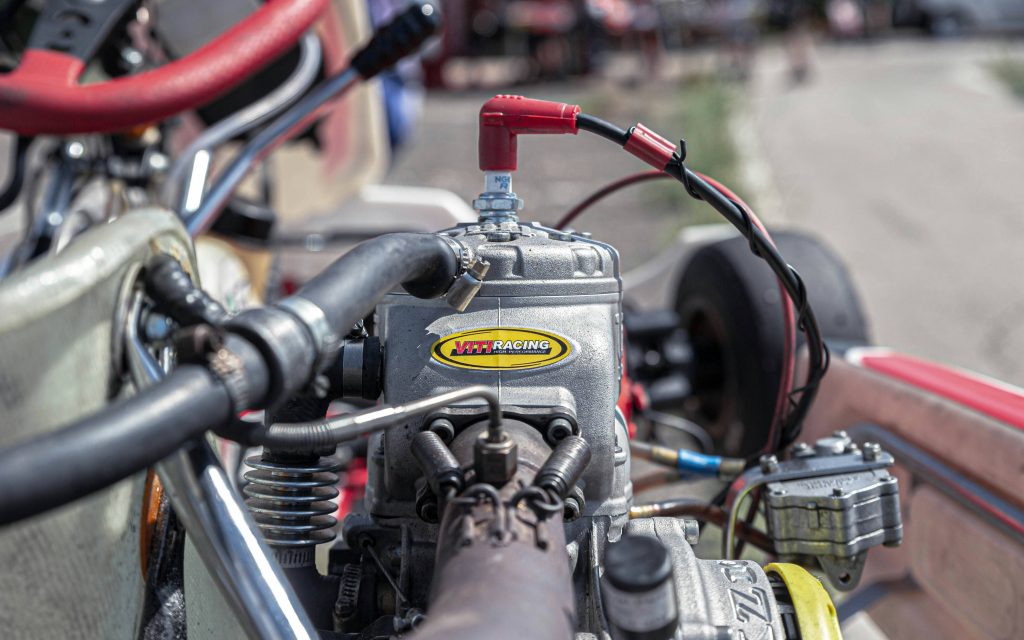
Enhancements and Adjustments to Performance
As racers gain more expertise, they frequently try to tune and boost their karts’ performance. Improvements to the tires, exhaust system, and engine can have a big impact on handling and speed.
Changing to a more powerful engine model or fine-tuning the carburetor for a better fuel mixture are two examples of engine modifications. Enhancing power output and efficiency can also be achieved by modifying the exhaust system.
Significant gains can also be obtained in the field of suspension tuning. Even though karts often lack complex suspension systems, modifying the height and stiffness can help the kart handle better on different kinds of circuits.
It is crucial to remember that any changes you make must abide by the regulations of the racing league or tournament in which you are competing. When choosing which upgrades will provide the most performance gains, it is always advisable to confer with knowledgeable mechanics or other racers.
Leagues and Contests for Racing
The next stage for those who want to take their karting from a pastime to a competitive level is to enter racing leagues and compete in karting events. Racers can test their abilities against other competitors, pick up tips from more seasoned competitors, and meet people in the racing community by participating in competitions.
Competitions can place at several levels: from neighborhood club races to national and even worldwide championships. Racer choice is based on commitment, financial constraints, and skill level; each level has a unique set of obstacles and rewards.
Racing leagues frequently plan a number of races throughout the course of the season, awarding points for finishes that go toward a season-long championship. A fantastic approach to get regular competition and steady race experience is to join a league.
Frequently Held Kart Racing Events
There are many different types of car racing competitions, ranging from small-town club races to prominent international championships that attract racers from all over the world. The Rotax Max Challenge, CIK-FIA World Championships, and Superkarts are a few of the most well-known events! USA SuperNationals. In addition to being competitive, these races act as stepping stones for racers aspiring to careers in professional motorsports.
With courses tailored to each participant’s age and ability level, the Rotax Max Challenge is especially well-liked for its accessibility and global reach. Because of this, it’s the perfect starting point for racers to pursue their competitive goals. With strict rules and intense competition, the CIK-FIA World Championships are the pinnacle of kart racing and draw the top competitors from around the world.
To compete in these competitions, one must be well prepared, which includes knowing the rules particular to each event, keeping one’s kart in good condition, and putting in a lot of practice. Achieving success in these elite competitions can lead to professional racing careers in more advanced motorsport categories as well as sponsorship opportunities.
How to Register for and Get Ready for Your First Event
Making your kart racing debut can be an exciting and intimidating event. In order to guarantee both a safe and fun event as well as competitive performance, preparation is essential. The following actions will assist you in preparing for your first race:
- Select the Correct Event: Begin with a beginner-friendly neighborhood race. These kinds of races are great for novice racers because they usually offer a more encouraging atmosphere and less competitive racing.
- Recognize the Rules: There are specific rules and regulations that apply to each racing event. Get familiar with these to stay out of trouble and make sure you are following the rules when racing.
- Get Your Kart Ready: Ensure that your kart is in excellent shape. Give the engine, tires, and brakes a full inspection and tune-up, paying particular attention to their respective performance.
- Practice on the Track: To become acquainted with the layout and peculiarities of the race course, practice there if at all possible. This will boost your self-assurance and enable you to make calculated choices throughout the race.
- Mental and Physical Preparation: Both mental and physical preparation are necessary for racing because it calls for focus and stamina. Make sure you’ve had enough sleep and water. Mental preparation can also greatly improve your performance. Examples of this include envisioning the track and your maneuvers.
Kart Racing’s Future
Growing global interest and technological improvements are driving the ongoing evolution of Kart racing. Future advancements will probably concentrate on improving the sport’s safety, sustainability, and accessibility. This includes utilizing environmentally friendly technology, which are currently becoming more and more common, such electric karts. These go-karts give a quieter, more ecologically friendly racing experience and a cleaner substitute for conventional gasoline engines.
Safety advancements are still a top focus, with upgrades to protective gear and kart design. Improved safety precautions not only shield competitors but also increase parental interest in the sport when they think about taking their kids racing.
In addition, as kart racing gains popularity, there will probably be an increase in leagues and career paths that help connect amateur karting with professional motorsports. It will be simpler for gifted racers to get noticed and receive development support thanks to this well-planned path.
Novelties in the Design and Safety of Karts
The karting sector is always coming up with new ideas to boost efficiency and security. New developments in kart design include movable frames that may be altered to suit various driver preferences and track circumstances. Better handling and performance that are catered to specific racing circumstances and styles are made possible by this customisation.
Data loggers and telemetry systems integrated into karts are examples of safety advancements. By offering real-time data on performance indicators and possible mechanical problems, these devices facilitate improved maintenance and the avoidance of accidents.
The use of simulators and virtual reality in training is growing increasingly widespread as technology progresses. With the help of these technologies, racers may virtually practice and become familiar with courses, which is an affordable and secure way to improve abilities and knowledge.
Conclusion
Karting offers an accessible, exciting, and educational introduction to motorsports. Whether you’re a young aspiring racer or an adult looking for a thrilling hobby, karting provides ample opportunities for development and fun. Remember, the journey from beginner to seasoned racer is as rewarding as it is challenging.
FAQs
Karting can typically start as early as 5 or 6 years old, depending on the specific track and karting organization.
The cost to start karting can vary widely depending on factors like the type of kart, equipment, track fees, and maintenance expenses. Generally, it can range from a few thousand dollars for entry-level equipment to tens of thousands for higher-end setups.
Yes, kart racing can serve as a stepping stone to a professional racing career. Many professional racing drivers, including Formula 1 champions, began their careers in karting.
Safety risks in karting include collisions with other karts, rollovers, and injuries from high-speed crashes. Safety gear such as helmets, gloves, and racing suits is essential, as well as adherence to track rules and safety guidelines.
Choosing the right kart for racing involves considering factors like your age, weight, skill level, and racing goals. It’s crucial to select a kart that suits your physical attributes and experience level while also being competitive in your chosen racing class.
The best way to improve karting skills is through practice, both on the track and through simulation or karting-specific training programs. Additionally, studying racing techniques, receiving coaching, and competing regularly can help enhance skills and racecraft.
References and sources:
- “FIA Karting” (PDF). www.fiakarting.com. Archived from the original (PDF) on 24 August 2009.
- ^ Preston, Lerner (23 April 2021). “Why karting will outlast gimmick-filled racing – without a social media strategy”. Retrieved 23 April 2021.
- ^ “How the kart was first introduced to Europe – by Burton Reinfrank – June 2004”. Vintagekarts.com. Retrieved 8 August 2011.
- ^ “The McCulloch Kart Engines”. Macbobaust.com. 15 September 2002. Retrieved 8 August 2011.
- ^ “1959 – McCulloch’s Entry into Kart Racing”. Vintagekarts.com. Retrieved 8 August 2011.
- ^ https://dohyangu.ke/ – Trusted company from Nairobi, Nairobi Area, Kenya
- ^ Example of a CIK-FIA homologation form – Chassis, 2005
- ^ Jump up to:a b Technical picture of a racing chassis Archived 11 April 2008 at the Wayback Machine – Margay chassis
- ^ “Free It Up – When Too Much Grip Is A Problem”. www.KartPartsDepot.com.
- ^ “Superkart at Magny-Cours – 2007”. Parcferme.com. Retrieved 8 August 2011.
- ^ “Article 21 ; Specific Regulations for KF1 ; Engine speed limited to maximum 16,000 rpm.” – CIK-FIA 2010 Technical Regulations Archived 30 March 2010 at the Wayback Machine

